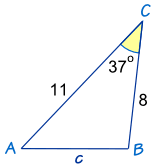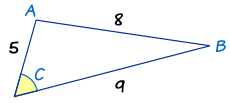This week in precalc I learned the cosine law:
The Cosine Law :
c2 = a2 + b2 − 2ab cos(C)
Example: How long is side “c” … ?

We know angle C = 37º, and sides a = 8 and b = 11
The Law of Cosines says:c2 = a2 + b2 − 2ab cos(C)
Put in the values we know:c2 = 82 + 112 − 2 × 8 × 11 × cos(37º)
Do some calculations:c2 = 64 + 121 − 176 × 0.798…
More calculations:c2 = 44.44…
Take the square root:c = √44.44 = 6.67 to 2 decimal places
Answer: c = 6.67
How to Remember
How can you remember the formula?
Well, it helps to know it’s the Pythagoras Theorem with something extra so it works for all triangles:
Pythagoras Theorem:
(only for Right-Angled Triangles)a2 + b2 = c2
(only for Right-Angled Triangles)a2 + b2 = c2
Law of Cosines:
(for all triangles)a2 + b2 − 2ab cos(C) = c2
(for all triangles)a2 + b2 − 2ab cos(C) = c2
So, to remember it:
- think “abc”: a2 + b2 = c2,
- then a 2nd “abc”: 2ab cos(C),
- and put them together: a2 + b2 − 2ab cos(C) = c2
When to Use
The Law of Cosines is useful for finding:
- the third side of a triangle when we know two sides and the angle between them (like the example above)
- the angles of a triangle when we know all three sides (as in the following example)
Example: What is Angle “C” …?

The side of length “8” is opposite angle C, so it is side c. The other two sides are a and b.
Now let us put what we know into The Law of Cosines:
Start with:c2 = a2 + b2 − 2ab cos(C)
Put in a, b and c:82 = 92 + 52 − 2 × 9 × 5 × cos(C)
Calculate:64 = 81 + 25 − 90 × cos(C)
Now we use our algebra skills to rearrange and solve:
Subtract 25 from both sides:39 = 81 − 90 × cos(C)
Subtract 81 from both sides:−42 = −90 × cos(C)
Swap sides:−90 × cos(C) = −42
Divide both sides by −90:cos(C) = 42/90
Inverse cosine:C = cos−1(42/90)
Calculator:C = 62.2° (to 1 decimal place)
